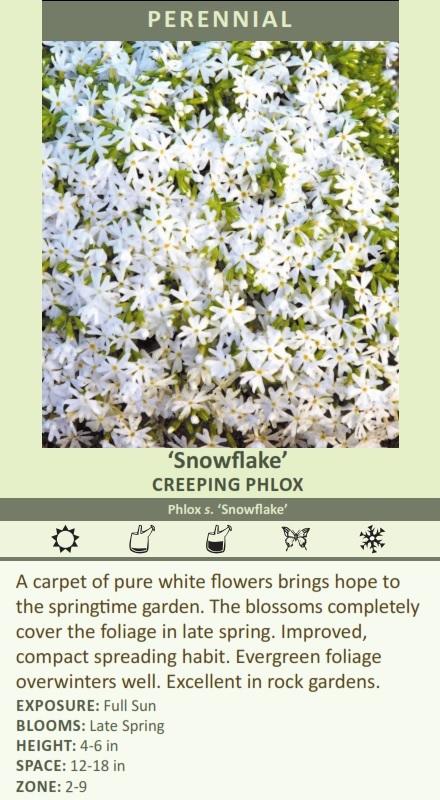Answer
Mar 09, 2025 - 12:09 PM
Gardeners have a saying about planting perennials: “The first year, they sleep; the second year, they creep; and the third year, they leap.” The best tip for successful planting is simple, “Right plant, right place.” If you want a perennial to survive and grow, the plant must tolerate year-round conditions in your zone including lowest and highest temperatures, the amount of rainfall it receives and appropriate amount of sunshine.
Creeping phlox is not fussy but does have specific needs, though it is probably too early to worry about the lack of growth, even with the loss of two plants.
However, in case there is an issue, let me suggest a few key areas to troubleshoot.
Likely Culprits and Specific Recommendations (Prioritized):
- Insufficient Sunlight (Most Likely):
- Problem: If the phlox is getting less than 6 hours of direct sun, it simply will not grow well.
- Recommendation: "The most important thing for creeping phlox is full sun. If your 'Snowflake' is not getting at least 6 hours of direct sunlight each day, it will likely need to be moved to a sunnier location. This is often the #1 reason why creeping phlox fails to thrive."
- If moving is not possible: Consider if any trees or shrubs have grown, blocking the sun.
- Poor Drainage / Heavy Clay Soil (Very Likely):
- Problem: Phlox subulata needs excellent drainage. Heavy clay, compacted soil, or areas where water puddles are a recipe for disaster.
- Recommendation: "Creeping phlox really dislikes wet feet. If your soil is heavy clay or does not drain well, this is a major problem. I would strongly recommend amending the soil extensively before replanting (or when you move them for more sun). Add plenty of compost and consider incorporating some coarse sand or fine gravel to improve drainage. A raised bed or planting on a slight slope can also make a huge difference."
- If the soil is compacted: Suggest testing it by digging. If it is hard, refer to recommendations.
- Incorrect Watering (Likely, in Combination with Drainage):
- Problem: Overwatering, especially in poorly drained soil, is deadly to creeping phlox. Underwatering, especially in the first year, can also stunt growth.
- Recommendation: "Creeping phlox is relatively drought-tolerant once established, but it does need consistent moisture while getting started. However, overwatering is a much bigger risk. Allow the soil to dry out slightly between waterings. The 'finger test' is helpful: stick your finger into the soil; if it feels dry an inch or two down, it is time to water. If it's still damp, wait."
- Planting Depth (Possible, but Less Likely than the Above):
- Problem: Planted too deep, the crown can rot.
- Recommendation: "Make sure the plants weren't planted too deeply. The crown of the plant (where the stems meet the roots) should be level with the surrounding soil. If they're buried too deep, gently lift and replant them."
- Soil pH (Less Likely, but Worth Checking):
- Problem: While Phlox subulata is adaptable, extremely acidic soil might hinder growth.
- Recommendation: "A soil test is the best way to determine the pH. If your soil is very acidic (below 6.0), you might consider adding a small amount of lime according to the soil test recommendations. But focus on sun and drainage first."
- Pests or Diseases.
- Problem: Unseen pests, such as nematodes.
- Recommendations:
- Careful inspection: Examine the roots when/if the plants are dug up.
- Ask if they have seen any pests.
- Suggest beneficial nematodes, to fight the harmful ones.
General Advice:
- Emphasis on Full Sun: This is non-negotiable for Phlox subulata.
- Emphasis on Excellent Drainage: This is almost as important as the sun.
- De-emphasis on Fertilizing: Phlox subulata does not need rich soil.
- More Specific Watering Advice: Tailored to the plant's drought tolerance.
- Inclusion of pH: While not the top priority, it is relevant to this specific plant.
The key is to address the most likely problems first and take steps.
 Bloomin Designs Nursery
Bloomin Designs Nursery

